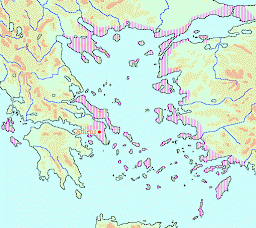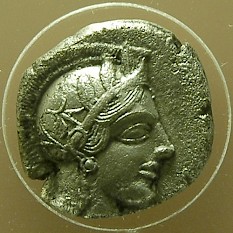Persian Influence on Athenian politics
The ancient Persian and Greek cultures did not exist in isolation. There was cross-fertilization. The present article describes several aspects of Persia's influence on Greece.
Politics

As we have seen above, Athens brought the war against the Persian Empire to a good ending and discovered the opportunities offered by the Delian League. As long as the war against Persia had been going on, its members had had every reason to remain united, but now that the immediate cause was removed, Athens had to look for a tool to keep its nascent empire together.
Member states that wanted to leave the League, were brutally attacked. The smaller city states, which could use some help and protection, were inclined to side with Athens, but others, which resented the tribute and the increasing Athenian involvement in their internal affairs, were visited by the Athenian navy and forced into surrender (e.g., Naxos in 470 and Thasos in 465). These towns, which had been forced to remain in the League, had another status than the cities that obeyed Athens. They had to disband their navies, had to pay tribute in cash, and lost much of their autonomy. If they were not democratic, they were forced to change their constitution.
At a later stage, towns that had always paid their tribute in cash were equaled with the subject cities. The number of autonomous cities diminished. When the Peloponnesian War broke out in 431 BCE, only Chios and Lesbos had retained some of their former independence.

But it was not just military power that helped Athens become the master of a great part of Greece; its economic power was a source of strength as well. The Athenian port was the center of interregional commerce and the city had commercial treaties with many towns and nations inside and outside the League. It controlled the monetary system and ordered that only the famous Athenian "owl"-coins and weights were to be used in commercial transactions.
Athens also founded colonies (cleruchies). These were meant to repopulate subject towns from which a part of the population had been expelled. This gave the Athenians a stronghold in potentially unquiet areas, because the colonists retained their Athenian citizenship and did not have to pay tribute. After 450, Athens started to station garrisons throughout its empire.
Every town in the Athenian empire, whatever its precise status, was supervised by an episcopus or overseer. This Athenian magistrate kept an eye on the town where he resided. He controlled the payment of the tributes, was supposed to prevent insurrections and had to investigate evils and report them to the government at home.
All in all, the Delian League was a complex organization. We will now investigate whether the organization of the Achaemenid empire served as a model to the Athenian empire, and we will concentrate on the following aspects:
- the organization of the League, and its resemblances with and its differences from the structure of the Persian state, and especially the way tribute was paid;;
- the function and origin of the office of the episcopus.
Politics: Delian league
The most remarkable aspect of the Delian League is that it was a maritime empire. Earlier Greek (con)federations had all been land-based. A maritime empire demands another kind of organization, not in the least because the lines of communication can be threatened in the winter, whereas transport between the member states is much cheaper. This makes it unlikely that a Greek league was the model of the Athenian empire, and it is possible that the western part of the Achaemenid Empire - with its maritime lines of communication and active navy - was the real source of inspiration.
The maritime organization of the western part of the Achaemenid Empire had been a result of king Cambyses' conquest of Egypt (525 BCE), which had been possible only after the building of a large imperial navy.note When Egypt had been defeated and added to the Achaemenid Empire, it was necessary to keep the navy to control the new region. Many men and lots of silver and gold were necessary for the upkeep, and the result was the monetarization of the tribute by king Darius I the Great, which is described in Book Three of the Histories by Herodotus of Halicarnassus. Although it was still possible to pay in kind, payments in cash were preferred.
The organization of the western Achaemenid Empire was, therefore, largely based on the demands of the navy, and the Athenians copied certain aspects of this. For example, the ships of the Persian navy had a mixed crew: the rowers came from various parts of the empire. The Athenian ships were partly manned by Athenians, partly by the allies. Towns in the Achaemenid Empire could pay their tribute by manning ships; the kings appreciated this type of tribute, because towns that had sent part of their manhood away, were less likely to revolt. The Athenians did the same.
But the main factor is the tribute system. After the Greeks had defeated the Persians, the Athenians took over the Persian fiscal organization of the Greek towns in Asia. After the Ionian revolt, the satrap of Lydia and Ionia, Artaphernes, had established the tribute that the Greek towns had to pay, and the Athenians did not change his system. Every four year, the Athenians and their subjects revised the tariff.
At least in theory, the subject towns could negotiate about the amount they owed to their masters, and it is tempting to link this fact to the remark by Herodotus that the Persians regarded king Darius as a merchant (kapelos) because he negotiated about everything.note This is really remarkable, because a king was not supposed to make deals with his subjects about the prize of his reign.
The negotiations between the ruler - whether Persian or Athenian - suggest a voluntariness and an equality which probably did not really exist. But the illusion was kept intact in both empires.
Politics: Episcopus
The functions of the episcopus have already been described: every town in the Athenian empire, whatever its status, was supervised by an Athenian episcopus or overseer. This official kept an eye on the town where he resided. He controlled the payment of the tributes, was supposed to prevent insurrections and had to investigate evils and report them to the Athenian government. Usually, the episcopus was elected by the people's assembly.
The Achaemenid empire knew similar officials, who were called "the eye of the king". They were appointed by the king to inform him of what was going on in the empire, had more powers than the satraps, and were responsible for a well-defined region. They supervised the policy of the satraps and the payment of tribute, oversaw how rebellions were suppressed, and reported evils to the king.
The similarities are remarkable. The "eye" and the episcopus are responsible only to the highest authorities, they are supervisors of the local rulers, are responsible for the taxation, and are -in case of troubles- the direct link to the central government.
Their name may be similar as well. The real Persian title of the Eye is not known, but may have been spasaka ("seer"). If so, episkopos (which also has an association with "to see") is a translation that remains close to the sound of the original. However, this hypothetical.
It should be stressed that every ruler uses officials like the Eyes to know what is happening. The names of these inspectors may be different, but there are some primitive tasks that have to be executed anyway. For example, Charlemagne employed missi dominici. The Athenian government needed to send out inspectors, like all rulers had to do. Nevertheless, because the job responsibilities of the Eye and the episcopus are so very similar, we must seriously entertain the possibility that the Athenians copied a Persian function.